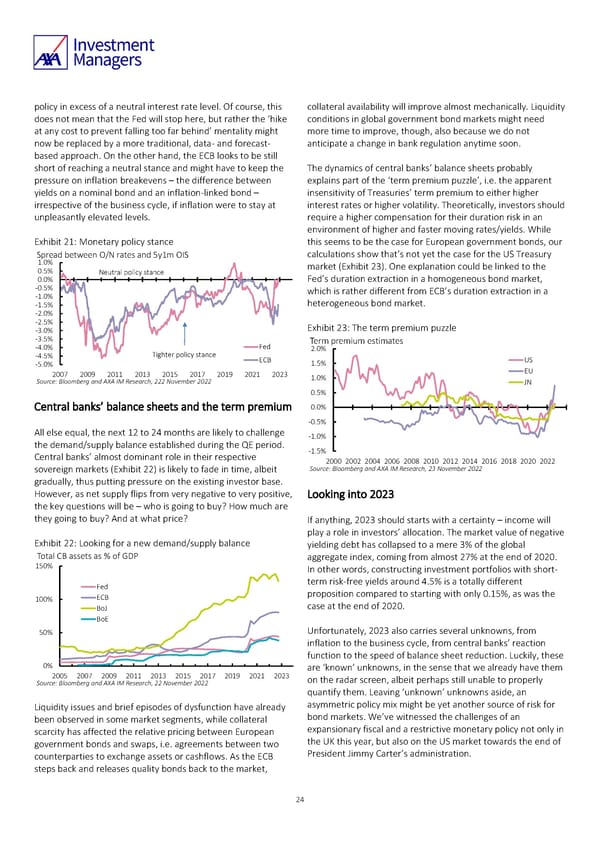policy in excess of a neutral interest rate level. Of course, this collateral availability will improve almost mechanically. Liquidity does not mean that the Fed will stop here, but rather the ‘hike conditions in global government bond markets might need at any cost to prevent falling too far behind’ mentality might more time to improve, though, also because we do not now be replaced by a more traditional, data- and forecast- anticipate a change in bank regulation anytime soon. based approach. On the other hand, the ECB looks to be still short of reaching a neutral stance and might have to keep the The dynamics of central banks’ balance sheets probably pressure on inflation breakevens – the difference between explains part of the ‘term premium puzzle’, i.e. the apparent yields on a nominal bond and an inflation-linked bond – insensitivity of Treasuries’ term premium to either higher irrespective of the business cycle, if inflation were to stay at interest rates or higher volatility. Theoretically, investors should unpleasantly elevated levels. require a higher compensation for their duration risk in an environment of higher and faster moving rates/yields. While Exhibit 21: Monetary policy stance this seems to be the case for European government bonds, our Spread between O/N rates and 5y1m OIS calculations show that’s not yet the case for the US Treasury 1.0% market (Exhibit 23). One explanation could be linked to the 0.5% Neutral policy stance 0.0% Fed’s duration extraction in a homogeneous bond market, -0.5% -1.0% which is rather different from ECB’s duration extraction in a -1.5% heterogeneous bond market. -2.0% -2.5% Exhibit 23: The term premium puzzle -3.0% -3.5% Term premium estimates -4.0% Fed 2.0% -4.5% Tighter policy stance ECB US -5.0% 1.5% 2007 2009 2011 2013 2015 2017 2019 2021 2023 1.0% EU Source: Bloomberg and AXA IM Research, 222 November 2022 JN 0.5% Central banks’ balance sheets and the term premium 0.0% -0.5% All else equal, the next 12 to 24 months are likely to challenge -1.0% the demand/supply balance established during the QE period. -1.5% Central banks’ almost dominant role in their respective 2000 2002 2004 2006 2008 2010 2012 2014 2016 2018 2020 2022 sovereign markets (Exhibit 22) is likely to fade in time, albeit Source: Bloomberg and AXA IM Research, 23 November 2022 gradually, thus putting pressure on the existing investor base. However, as net supply flips from very negative to very positive, Looking into 2023 the key questions will be – who is going to buy? How much are they going to buy? And at what price? If anything, 2023 should starts with a certainty – income will play a role in investors’ allocation. The market value of negative Exhibit 22: Looking for a new demand/supply balance yielding debt has collapsed to a mere 3% of the global Total CB assets as % of GDP aggregate index, coming from almost 27% at the end of 2020. 150% In other words, constructing investment portfolios with short- Fed term risk-free yields around 4.5% is a totally different 100% ECB proposition compared to starting with only 0.15%, as was the BoJ case at the end of 2020. BoE 50% Unfortunately, 2023 also carries several unknowns, from inflation to the business cycle, from central banks’ reaction function to the speed of balance sheet reduction. Luckily, these 0% are ‘known’ unknowns, in the sense that we already have them 2005 2007 2009 2011 2013 2015 2017 2019 2021 2023 on the radar screen, albeit perhaps still unable to properly Source: Bloomberg and AXA IM Research, 22 November 2022 quantify them. Leaving ‘unknown’ unknowns aside, an Liquidity issues and brief episodes of dysfunction have already asymmetric policy mix might be yet another source of risk for been observed in some market segments, while collateral bond markets. We’ve witnessed the challenges of an scarcity has affected the relative pricing between European expansionary fiscal and a restrictive monetary policy not only in government bonds and swaps, i.e. agreements between two the UK this year, but also on the US market towards the end of counterparties to exchange assets or cashflows. As the ECB President Jimmy Carter’s administration. steps back and releases quality bonds back to the market, 24
 AXA IM Outlook 2023 full report Page 23 Page 25
AXA IM Outlook 2023 full report Page 23 Page 25